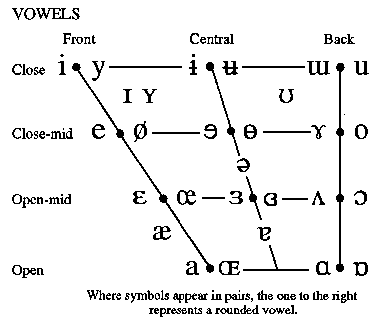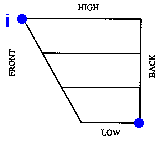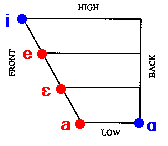Vowels

The idea of cardinal vowels
So far, we have been treating the IPA vowel symbols as standing
for the sounds that occur in certain English words.
This doesn't make it very easy for us to compare vowels between
languages or dialects. How do we write the difference between
monophthongal [o] in Winnipeg English and a monophthongal [o]
in Scottish English or a monophtongal [o] in Italian?
The IPA symbols for vowels are better seen as similar to
international standards for things like colour names.
"Red" paint has to be of a certain hue and intensity,
otherwise modifiers have to be added: "dull brick red".
Similarly, the symbol [o] refers to a vowel made with the
tongue body in a relatively exact place (and which will
therefore have the formants at certain frequencies). A very narrow
transcription would record any deviation from this place.
So the symbol [ ] does not stand for the vowel in English
father. It stands for the vowel that is the furthest back
and the lowest possible vowel in the vowel space (the vowel
with the highest F1 and the closest F2 to F1). Period.
Canadian English just happens to have the vowel in
father very close to this position. When we make
statements about other dialects, for example, when we say
that the typical pronunciation of the vowel of father in the
northern U.S. is more front than [
] does not stand for the vowel in English
father. It stands for the vowel that is the furthest back
and the lowest possible vowel in the vowel space (the vowel
with the highest F1 and the closest F2 to F1). Period.
Canadian English just happens to have the vowel in
father very close to this position. When we make
statements about other dialects, for example, when we say
that the typical pronunciation of the vowel of father in the
northern U.S. is more front than [ ], we aren't saying that
the Canadian pronunciation is more deserving of the symbol
[
], we aren't saying that
the Canadian pronunciation is more deserving of the symbol
[ ]
because it is somehow better, we are merely saying that the
northern U.S. pronunciation is not in the lowest, backest part
of the vowel space.
]
because it is somehow better, we are merely saying that the
northern U.S. pronunciation is not in the lowest, backest part
of the vowel space.
 The idea of cardinal vowels originated with Daniel
Jones.
The idea of cardinal vowels originated with Daniel
Jones.
The cardinal vowel chart organizes the vowel space between the
two most extreme tongue body positions: high front [i] and low
back [ ].
].

The high/low dimension is divided into four equally spaced levels.
These correspond to the vowels we have been describing as:

- high tense
- mid tense
- mid lax
- low
The four back cardinal vowels are [u], [o], [ ], and
[
], and
[ ].
].
The equal spacing between the height levels can be determined
articulatorily (make your tongue body move in four equal steps
from high to low) or acoustically (divide the F1 dimension into
four levels from lowest to highest). Jones' original proposal only
considered the articulatory definition.
Other vowels are placed on the vowel chart using these
cardinal vowels as landmarks.
The eight vowels seen so far are called the primary
cardinal vowels. The secondary cardinal vowels
are obtained by using the opposite lip-rounding on each
primary cardinal vowel. The primary and secondary cardinal
vowels are often referred to by a number as well as by
their symbols.
| 1 | [i] | | 9 | [y] |
| 2 | [e] | | 10 | [ø] |
| 3 | [ ] ] | | 11 | [ ] ] |
| 4 | [a] | | 12 | [ ] ] |
| 5 | [ ] ] | | 13 | [ ] ] |
|
| 6 | [ ] ]
| |
14 | [ ] ] |
| 7 | [o] | |
15 |
[ ] ] |
| 8 | [u] | |
16 | [ ] ] |
On the IPA vowel chart, the rounded vowels are always listed to the right
of the corresponding unrounded vowel. (Besides being consistent, this
also reflects their relative positions on formant graphs. Recall that lip
rounding will lower F2, and lower F2s are toward the right end of the standard
vowel chart.)
Next: IPA and North American vowel charts
Previous: Multiple articulations
Up: table of contents
 ] does not stand for the vowel in English
father. It stands for the vowel that is the furthest back
and the lowest possible vowel in the vowel space (the vowel
with the highest F1 and the closest F2 to F1). Period.
Canadian English just happens to have the vowel in
father very close to this position. When we make
statements about other dialects, for example, when we say
that the typical pronunciation of the vowel of father in the
northern U.S. is more front than [
] does not stand for the vowel in English
father. It stands for the vowel that is the furthest back
and the lowest possible vowel in the vowel space (the vowel
with the highest F1 and the closest F2 to F1). Period.
Canadian English just happens to have the vowel in
father very close to this position. When we make
statements about other dialects, for example, when we say
that the typical pronunciation of the vowel of father in the
northern U.S. is more front than [ ], we aren't saying that
the Canadian pronunciation is more deserving of the symbol
[
], we aren't saying that
the Canadian pronunciation is more deserving of the symbol
[ ]
because it is somehow better, we are merely saying that the
northern U.S. pronunciation is not in the lowest, backest part
of the vowel space.
]
because it is somehow better, we are merely saying that the
northern U.S. pronunciation is not in the lowest, backest part
of the vowel space.

 The idea of cardinal vowels originated with Daniel
Jones.
The idea of cardinal vowels originated with Daniel
Jones.


 ], and
[
], and
[ ]
]  ]
]  ]
]  ]
]  ]
]  ]
]  ]
]